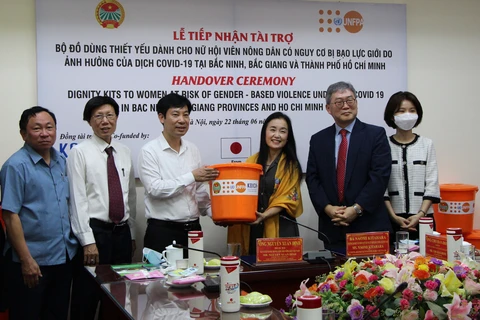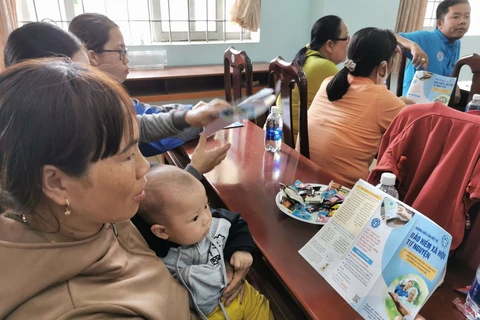Hanoi (VNA) — The gender gaps within and between the ethnic minority groups and the Kinh ethnic group remain substantive and persist across various socio-economic fields, according to reports conducted by a group of international organisations and local authorities.
The two reports on “Figures on ethnic minority women and men in Vietnam 2015-2019” and “Policy Brief: Gender issues in ethnic minority areas in Vietnam” were released on August 4 for the International Day of the World’s Indigenous Peoples (August 9).
They were launched by the United Nations Entity for Gender Equality and the Empowerment of Women (UN Women), in coordination with the Institute of Labour Science and Social Affairs under the Ministry of Labour, Invalids and Social Affairs (ILSSA-MOLISA), the Committee for Ethnic Minority Affairs (CEMA)’ Department of Ethnic Minority Affairs and the Embassy of Ireland in Vietnam.
The two publications cover information on ethnic minority women and men in Vietnam for the period of 2015-2019, including gender analysis outcomes, and provide policy recommendations for gender equality promotion in ethnic minority areas in Vietnam.
Data in the reports were analysed based on the findings of the Survey on the Socio-economic Situation of the 53 Ethnic Minority Groups in Vietnam, which was conducted by the General Statistics Office in collaboration with CEMA in 2015 and 2019.
The main topics covered in the reports include Population; Infrastructure and assets; Labour, employment, and income; Education and training; Culture and society; Health, environment, and sanitation; and Ethnic minority cadres and civil servants.
Gender disaggregated data analyses show outstanding achievements in gender equality in ethnic minority and mountainous areas in the period of 2015 to 2019.
The percentage of ethnic minority households with access to the Internet (Wi-fi, cable, or 3G) increased 9.4 times from 6.5 percent in 2015 to 61.3 percent in 2019. The proportion of children attending school at the right age increased by 15.2 percent from 2015 to 2019.
The percentage of ethnic minority people participating in health insurance reached 93.5 percent with no difference between men and women. The rate of child marriage in ethnic minority groups reduced by 4.7 percentage point.
The average income per capita per month of ethnic minorities in 2018 increased by 1.8 times in four years, and the average monthly income per capita of ethnic minority female-led households was always higher than that of male-led households.
The reports also highlight persistent gender issues in ethnic minority and mountainous areas which are affecting women and girls. For instance, while the overall rate of child and consanguineous marriage among the 53 ethnic minority groups has reduced, the extent of reduction was uneven and has continued to increase among a number of ethnic minority groups.
“In ethnic minority communities, women and girls are often more disadvantaged in accessibility to opportunities and resources due to social norms which impose an inferior position on them, limit them within birth delivery and household production activities,” said Bui Ton Hien, Director of ILSSA-MOLISA. “The intersection of various forms of gender and ethnicity-based discrimination bear the most impact.”
The analysis found that female ethnic minority workers are more likely to undertake insecure jobs and are more vulnerable in the workplace than their ethnic minority male and Kinh female counterparts. Also, while the percentage of ethnic minority women aged 10-49 who give birth at health facilities reached 86.4 percent, it remains significantly lower than that of Kinh women which is over 99 percent.
Elisa Fernandez Saenz, UN Women Representative in Vietnam said “gender equality issues which intersect with ethnicity are often difficult to tackle and require a comprehensive approach, as well as commitments of financial investment in the coming years.”
“UN Women believes that these reports shall contribute to filling the gap of gender statistics among ethnic minority groups in Vietnam, and to the progress of promoting socio-economic and sustainable development in ethnic minority areas,” she said.
“The objective of the reports is to provide stakeholders with a clearer picture on the current gender equality situation in ethnic minority areas in Vietnam, wherein gender issues are being well addressed by the government, but which needs further effort for intervention in both areas of policy and programme.”
Luu Xuan Thuy, Director of the CEMA’ Department of Ethnic Minority Affairs believed that gender equality analyses in ethnic minority areas are fundamental information and useful for the stakeholders in designing policies and intervention programmes to ensure that ethnic minority women are not left behind in the country’s sustainable development process./.

Canada assists women-led enterprises in Vietnam
The Trade Facilitation Office (TFO) Canada and the Vietnamese Ministry of Industry and Trade’s Trade Promotion Agency (VIETRADE) signed a cooperation agreement via videoconference on June 1 to improve the export capacity of women-led enterprises in Vietnam during the 2021-2024 period.























